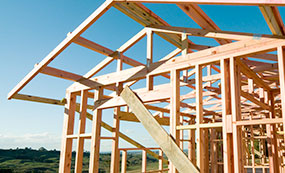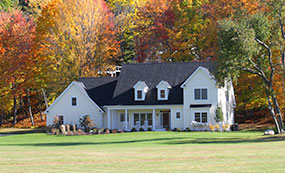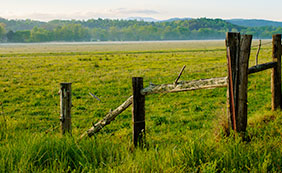A new home construction guide for planning and financing your country home in the Northeast

Whether you already own rural land or are searching for your future construction site, building a home in the country doesn’t have to be a hassle. With help from the right team, you can rest easy knowing all your planning and financing needs are being handled from lot purchase to final mortgage.
For more than 100 years, Country Living Loans, the mortgage lending arm of Farm Credit East, has financed farms, land and country homes across the Northeast.
Today, we serve customers throughout Connecticut, Maine, Massachusetts, New Hampshire, Rhode Island, Vermont, New York and New Jersey, and we continue to provide local, personalized service to the rural residents within our territory.
Our experienced Country Living Loans mortgage specialists work with the unique requirements of rural properties every day. That’s why we developed the following guide on building a country home to your new home construction project every step of the way.
Part one of the guide explores construction site considerations. Part two explains how to secure financing for your project.
Part 1: Construction Site Considerations
Two of the most important factors to consider when buying undeveloped land for new home construction include the unique features of the property and the location of the site itself.
“Road frontage, septic systems, access to water and electric services are important aspects rural property hunters need to keep in mind when building in the country,” says Leigh-Ann Harvatine, a Country Living Loans mortgage specialist covering the central New York region.
Other examples include conducting a perc test to measure soil drainage, researching zoning limitations and estimating the costs needed to complete site work for future construction.
Because the location of a rural property influences land values, Harvatine says buyers should also consider distance to major roadways and proximity to metro areas that can provide employment and education opportunities, medical services, shopping, and other recreational amenities.
“Many lenders won’t finance vacant land because of the risk involved, and if they do, they often have acreage limits or require a large down payment and higher interest rates,” says Harvatine. “Our lot loans give you the flexibility to purchase land now and build at some point in the future. And if you’re ready to build, we offer a one-time closing for construction to permanent financing.”
“Unlike other lenders, your interest rate for home construction will be fixed at loan closing and remain fixed through both the construction phase and the entire life of your loan,” she adds. “And, we have a huge database of rural land sales and the expertise to help guide you through the loan process.”
Part 2: Securing Financing
Once you’ve found the perfect site to build your future home, the next step involves planning for the construction phase and securing financing for your project.
As a rule of thumb, Harvatine recommends starting the rural home construction loan process at least two to three months before breaking ground.
“The loan process takes anywhere from 45-60 days,” Harvatine says. “We know buying land and building a home in the country is usually a once in a lifetime opportunity for our customers, so we want to be a friendly face and a resource for you to bounce ideas off of as you’re planning for construction.”
Since a construction loan with Country Living is completed in one closing, buyers typically have a 12-month timeframe to begin construction. During this time, Harvatine encourages buyers to get organized and do their homework as they finalize the details of their country home.
“If you plan to buy land and build a house all at once, you need to have your house plans ready to go when we do the appraisal,” she says. “That includes everything from the type of home being built, such as a modular, stick built or a log home, to the quality of the finishes you plan to install.”
Although a general contractor is not necessarily required, it’s a good idea to compare multiple estimates and select a reputable builder who is looking out for your best interests.
“Don’t be afraid to check out the quality of other homes if you have a particular builder in mind,” Harvatine says. “Our appraisers can help walk you through this decision making process and let you know if any costs have been overlooked.”
Harvatine also recommends visiting the local tax assessor to determine how the property will be assessed once it is no longer considered vacant land.
In addition to higher taxes, she says buyers should count on having cost overruns with their home construction project.
“We like to factor in at least 10 percent for cost overruns,” Harvatine says. “As part of the underwriting process you’ll need to show you have money saved up or liquid funds available for unexpected costs, and as your lender we want to ensure we’re helping you stay within your borrowing capacity.”
According to Harvatine, getting pre-qualified for a new construction loan is a great way to calculate what you can comfortably afford.
“By starting the loan process early, we can help you work within your budget as you prepare your plans and estimates,” she says.
Ready to Get Started?
In general, the loan process for rural home construction is the same for land loan and home mortgage financing.
Step 1: Initial Contact
As soon as you start thinking about building a home in the country, give us a call. Our mortgage specialists can help answer any questions you may have and provide a clear explanation of your loan request.
Step 2: Prequalification
Whether you already own rural land or are searching for a site for future construction, consider getting prequalified. This step can help save you time and avoid delays once you’ve found your perfect place in the country.
Step 3: Application
Ready to move forward on your dream property? Submit a formal application along with documents that demonstrate proof of income as well as a record of your assets and liabilities.
For new home construction projects, plans, drawing and building specifications, a signed sworn construction statement itemizing acquired bids or builder’s contract, and a general contractor name, address and phone number are also required. Additionally, a copy of the settlement statement form may be requested if the land has been owned less than one year.
Step 4: Conditional Approval
Our team will review your file and provide a personalized list of conditions needed to bring your file to closing. We work hand-in-hand with you to fulfill these conditions and keep you informed of any information still needed.
Step 5: Appraisal
As part of the loan process, an appraisal of the property will be conducted. The appraiser will reach out to the property contact and you will receive a copy upon completion.
Step 6: Final Approval
Once all conditions have been met, we will issue a final commitment, meaning no other items are needed as long as closing takes place within a specific time period.
Step 7: Attorney Title Work
An attorney must certify that a title or title insurance has been obtained for a lender to finance the property.
Step 8: Closing
A date is set and all documents are prepared for that date. The borrowers, attorney(s), and lender sit down to go over documents and finish the loan process.
Step 9: Draw Schedule
Funds are advanced on an agreed upon draw schedule by the borrower and builder. Once construction begins, our mortgage specialists will keep track of the progress and advance money from the loan as needed.
“One of the biggest advantages of working with Farm Credit East is that we only charge interest during the building phase on the funds that have been advanced,” says Harvatine. “This saves you from making full principal and interest payments on the total loan amount right away, so your payments will gradually increase over time and you’ll settle into the principal and interest payments only when construction is done.”
“Don’t cut corners, that’s my biggest advice,” she adds. “New home construction is not a project where you want to rush through planning and financing. The best thing you can do is plan ahead and be realistic about your goals. Our experienced mortgage specialists are here to help provide you with personalized service every step of the way.”
If you are building a home in the country in New York, Maine, New Jersey, Connecticut, Massachusetts, New Hampshire, Rhode Island or Vermont, Country Living Loans can help guide you through the process.
Contact your local mortgage specialist to learn more about rural home construction financing today.









